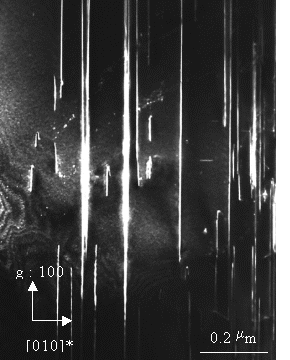

The high pressure polymorphs of olivine, wadsleyite and ringwoodite are likely to control the rheology of the transition zone. It is thus important to determine their deformation mechanisms at high-pressure and high-temperature. Multianvil deformation experiments using simple shear geometry can achieve large strains (see Annual Reports 1998 and 1999) and produce strong fabrics. We present here a TEM characterisation of the slip systems activated in wadsleyite deformed in such conditions.
The wadsleyite samples were synthesised from San Carlos olivine powder annealed for 3 hours at 15 GPa and 1300°C. After the run, the specimen was recovered, sliced, and put in a shear assembly to induce plastic deformation. Two deformation experiments were run for 1 and 8 hrs at 14 GPa and 1300°C.
The same microstructures are observed in those two samples showing that steady deformation is maintained over long periods of time in such experiments (Fig. 3.1-5). The dislocations are in glide configuration. Three slip systems appear to be dominant: [100](010), [100](011) and 1/2[111](101).
 |

Tel: +49-(0) 921 55 3700 / 3766, Fax: +49-(0) 921 55 3769, E-mail: bayerisches.geoinstitut(at)uni-bayreuth.de
 Previous page
Previous page